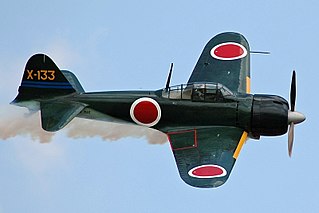
The Mitsubishi A6M "Zero" is a long-range carrier-based fighter aircraft formerly manufactured by Mitsubishi Aircraft Company, a part of Mitsubishi Heavy Industries. It was operated by the Imperial Japanese Navy (IJN) from 1940 to 1945. The A6M was designated as the Mitsubishi Navy Type 0 carrier fighter, or the Mitsubishi A6M Rei-sen. The A6M was usually referred to by its pilots as the Reisen, "0" being the last digit of the imperial year 2600 (1940) when it entered service with the Imperial Navy. The official Allied reporting name was "Zeke", although the name "Zero" was used colloquially as well.

Rabaul is a township in the East New Britain province of Papua New Guinea, on the island of New Britain. It lies about 600 kilometres to the east of the island of New Guinea. Rabaul was the provincial capital and most important settlement in the province until it was destroyed in 1994 by falling ash from a volcanic eruption in its harbor. During the eruption, ash was sent thousands of metres into the air, and the subsequent rain of ash caused 80% of the buildings in Rabaul to collapse. After the eruption the capital was moved to Kokopo, about 20 kilometres (12 mi) away. Rabaul is continually threatened by volcanic activity, because it is on the edge of the Rabaul caldera, a flooded caldera of a large pyroclastic shield volcano.

The Mitsubishi A5M, formal Japanese Navy designation Mitsubishi Navy Type 96 Carrier-based Fighter (九六式艦上戦闘機), experimental Navy designation Mitsubishi Navy Experimental 9-Shi Carrier Fighter, company designation Mitsubishi Ka-14, was a WWII-era Japanese carrier-based fighter aircraft. The Type number is from the last two digits of the Japanese imperial year 2596 (1936) when it entered service with the Imperial Navy.
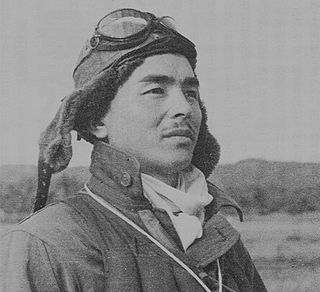
Lieutenant Junior GradeHiroyoshi Nishizawa was a Japanese naval aviator and an ace of the Imperial Japanese Navy Air Service during World War II. Nishizawa was known to his colleagues as 'the Devil' for his breathtaking, brilliant, and unpredictable aerobatics and superb control of his aircraft while in combat. He was a member of the Tainan Kōkūtai's famous "clean up trio" with fellow aces Saburō Sakai and Toshio Ōta and would see action in the New Guinea campaign as well as in the aerial battles over Guadalcanal and over the Solomon Islands. He was killed in 1944 during the Philippines Campaign while aboard an IJN transport aircraft. It is possible that he was the most successful Japanese fighter ace of the war, reportedly telling his last CO that he had achieved a tally of 86 or 87 aerial victories- post war he was linked with scores of 147 or 103, but both of these scores have been considered inaccurate.
The Kita and Minami Fortresses were defensive structures of the Imperial Japanese Army and Imperial Japanese Navy in the Kuril Archipelago.

The Rabaul caldera, or Rabaul Volcano, is a large volcano on the tip of the Gazelle Peninsula in East New Britain, Papua New Guinea, and derives its name from the town of Rabaul inside the caldera. The caldera has many sub-vents, Tavurvur being the most well known for its devastating eruptions over Rabaul. The outer flanks of the highest peak, a 688-metre-high asymmetrical pyroclastic shield, are formed by thick pyroclastic flow deposits. There is no sign of a pyroclastic shield along the rim of the caldera, making the location likely underwater, on the caldera's floor.
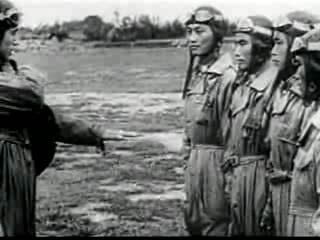
The Second Sino-Japanese War began on 7 July 1937 with the Marco Polo Bridge incident in the Republic of China and is often regarded as the start of World War II as full-scale warfare erupted with the Battle of Shanghai, and ending when the Empire of Japan surrendered to the Allies in August 1945. The Chinese Air Force faced the Imperial Japanese Army and Navy Air Forces and engaged them in many aerial interceptions, including the interception of massed terror-bombing strikes on civilian targets, attacking on each other's ground forces and military assets in all manners of air interdiction and close air support; these battles in the Chinese skies were the largest air battles fought since World War I, and featured the first-ever extensive and prolonged deployment of aircraft carrier fleets launching preemptive strikes in support of expeditionary and occupation forces, and demonstrated the technological shift from the latest biplane fighter designs to the modern monoplane fighter designs on both sides of the conflict.
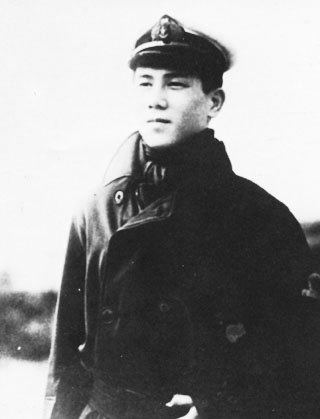
Lieutenant CommanderJunichi Sasai was a Japanese naval aviator and fighter ace of the Imperial Japanese Navy during World War II. Sasai was killed leading his fighter squadron during an attack on Henderson Field during the Battle of Guadalcanal.

Madang Airport, is an airport located in Madang, Papua New Guinea.
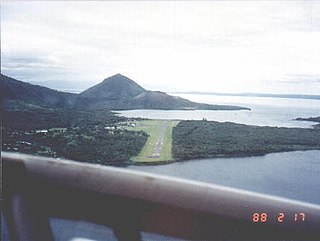
Rabaul Airport, also called Tokua Airport, is an airport serving Kokopo and Rabaul, the current and former capitals of East New Britain Province on New Britain island in Papua New Guinea.
Vunakanau Airfield was an aerodrome located near Vunakanau, East New Britain, Papua New Guinea. The airfield was constructed as a Royal Australian Air Force aerodrome and consisted of an unpaved single runway during World War II. The airfield was captured during the battle of Rabaul in 1942 by the Imperial Japanese and was extensively modified and expanded. Vunakanau was later neutralized by Allied air bombing in May 1944.

Technical Air Intelligence Units (TAIU) were joint Allied military intelligence units formed during World War II to recover Japanese aircraft to obtain data regarding their technical and tactical capabilities.
The Japanese Imperial Army landed the 25th Army under the command of General Tomoyuki Yamashita on the east coasts of Malaya and Thailand on the night of 7 December 1941.
The Fourth Air Army was a land-based aviation force of the Imperial Japanese Army. Formed in Rabaul in June 1943, consisting of the 6th and 7th Air Divisions. The air army was responsible for covering the Solomon Islands, Dutch New Guinea and the Territories of Papua and New Guinea areas of operations. The headquarters was at Rabaul. Disestablished in January 1945.
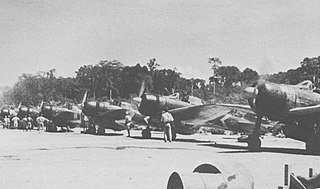
Kahili Airfield, also known as Buin Airfield, was an airfield located near Buin, Bougainville Island, Papua New Guinea.
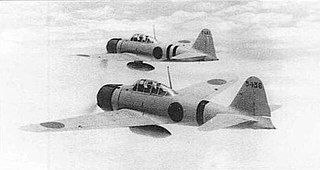
The 12th Air Group was a unit of the Imperial Japanese Navy Air Service (IJNAS) during the Second Sino-Japanese War that operated mainly in the campaigns in the Central China.
John Malcolm Smith was an American combat pilot who was a United States Navy fighter ace during World War II. He was credited with shooting down 10 Japanese aircraft during the last two years of the Pacific War. Smith received his law degree in 1950 and served in the United States Naval Reserve until his retirement in 1972.













